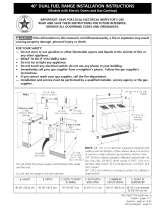
_iiii_ i i _ !_Zi_!Y: ii_i¸ii_iM__i;i_iii__i;i_ii#i_i__ Zi_ __ ___";;i_/___" i_ i _______iiiii_i!_i___iii_i_i ¸I_iii_!?______ii_ii _ _;_;_;_;i__ii __;_;_;_;_;_;_;_;_;_;_;_!S_,!',;._i;i__iiiiii_iiiiiiiii__i¸iii___iiiiiiiiiiii_i_iii_i_iii_iii_T__iiiiii_i_iii_iii_T_iiii_ii_i/ii_ii_i_!!ii!ii!i_i¸__i__i__i__i__i__i/_i_iii_iiii/i/i_i_i_i_i_i_i_i;_iI_i_Iii_Iii_Iii_Iii_Iii_Iii_Iii_Iii_Iii_Iii_Iii_Iii_Iii_Iii_Iii_Iii_Iii_Iii_Iii_Iii_Iii_Iiii¸;__ii/ii/ii/ii/_i
Important Installation Information
GAS type verification
Important:
Verify the type of gas supplied to the location. Ensure that the appliance is con-
nected to the type of gas for which it is certified. All models are certified for use with
natural gas. Field conversion of the appliance for use with propane gas supply will
require a conversion kit.
_ WARNING
To avoid possible burn or fire hazard, a backguard designed specifically
for this range must be installed whenever the range is used.
Refer to "Chart C: Backguard Kit Model Numbers" on page 23, for the correct
backguard models that are designed for this range, After selecting the correct
backguard, the range must be installed properly, using the minimum clear-
ances to combustible surfaces specified in the Cabinet Preparation instruc-
tions on Page 5,
A backguard must be utilized when there is less than a 12" horizontal clearance
between combustible materials and the back edge of the range. A Thermador
backguard must be ordered separately and installed at the rear of the range (A
Low Back is supplied with 30" model). For island installations and other installa-
tions with more than 12" clearance, an optional stainless steel Island Trim is
available to cover the backguard mounting flanges.
Verify that the appliance is correct for the type of gas being provided. Refer to
"Step 5: Gas Requirements and Hookup" on page 15 before proceeding with the
installation.
Gas Supply:
Electric Power Supply:
This appliance has been tested in accordance with ANSI Z21.1, Standard for
Household Cooking Appliances (USA) and in accordance with CAN 1.1-M81
Domestic Gas Ranges (Canadian).
It is stronqlv recommended that this appliance be installed in conjunction with a suit-
able overhead vent hood. (See "Step 1:Ventilation Requirements" on page 3.) Due
to the high heat capability of this unit, particular attention should be paid to the hood
and duct work installation to assure it meets local building codes.
Check local building codes for the proper method of appliance installation. Local
codes vary. Installation, electrical connections and grounding must comply with all
applicable codes. In the absence of local codes the appliance should be installed in
accordance with the National Fuel Gas Code ANSI Z223.1/NFPA 54 current issue
and National Electrical Code ANSI/NFPA 70-current issue. In Canada, installation
must be in accordance with the CAN 1-B149.1 and .2 - Installation Codes for Gas
Burning Appliances and/or local codes.
Natural Gas- 6 inch water column. (14.9 mb) min., 14 inch (34.9 mb) maximum
Propane Gas - 11 inch water column. (27.4 mb) min., 14 inch (34.9 mb) maximum
(See Page 17 for specifications.)
Page 2




















